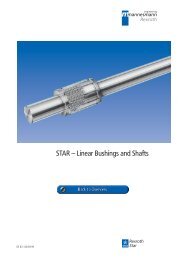STAR – Precision Ball Screw Assemblies
STAR – Precision Ball Screw Assemblies
STAR – Precision Ball Screw Assemblies
You also want an ePaper? Increase the reach of your titles
YUMPU automatically turns print PDFs into web optimized ePapers that Google loves.
<strong>STAR</strong> <strong>–</strong> <strong>Precision</strong> <strong>Ball</strong> <strong>Screw</strong> <strong>Assemblies</strong><br />
General<br />
DIN 69 051 Part 1 defines a<br />
ball screw as follows:<br />
An assembly comprising a ball screw shaft<br />
and a ball nut and which is capable of<br />
converting rotary motion into linear motion<br />
and vice versa.<br />
The rolling elements of the assembly are<br />
balls.<br />
Advantages over the Acme<br />
screw drive<br />
<strong>–</strong> The mechanical efficiency of an Acme<br />
screw drive is a maximum 50%,<br />
whereas a ball screw can reach a<br />
mechanical efficiency of up to 98%<br />
<strong>–</strong> Higher life expectancy due to negligible<br />
wear during operation<br />
<strong>–</strong> Less drive power required<br />
<strong>–</strong> No stick-slip effect<br />
<strong>–</strong> More precise positioning<br />
<strong>–</strong> Higher travel speed<br />
<strong>–</strong> Less heat-up<br />
Due to their high mechanical efficiency,<br />
ball screws are in principle not self-locking.<br />
Safety information<br />
We recommend that a safety nut be<br />
installed for particularly critical applications<br />
in vertical set-ups. Please ask.<br />
Efficiency (%)<br />
100<br />
90<br />
80<br />
70<br />
60<br />
50<br />
40<br />
30<br />
20<br />
10<br />
0<br />
0<br />
m = 0.005<br />
m = 0.01<br />
1 2 3 4 5 6 7 8 9<br />
Selection criteria for ball<br />
screws<br />
The following factors should be considered<br />
when selecting the ball screw for a given<br />
application:<br />
<strong>–</strong> degree of accuracy required (lead<br />
deviation)<br />
<strong>–</strong> in-service load conditions<br />
<strong>–</strong> service life<br />
<strong>–</strong> critical speed<br />
<strong>–</strong> buckling load<br />
<strong>–</strong> rigidity / permissible clearance or<br />
desired preload<br />
<strong>–</strong> charateristic speed<br />
The following points should be taken into<br />
consideration when selecting a ball screw<br />
assembly that is to be both cost-efficient<br />
and optimally designed:<br />
<strong>–</strong> The lead is a decisive factor for the<br />
load-carrying capacity (depending on<br />
the maximum possible ball diameter)<br />
and the drive moment.<br />
<strong>–</strong> The calculation of the service life should<br />
be based on average loads and average<br />
speeds, not on maximum values.<br />
<strong>–</strong> In order for us to provide you with a<br />
customized solution, installation<br />
drawings or sketches of the nut<br />
environment should be enclosed with<br />
your inquiry.<br />
m = 0.2<br />
m = 0.3<br />
<strong>Ball</strong> screw<br />
Acme screw<br />
Lead angle (°)<br />
N.B.:<br />
Radial and eccentric forces relative to the<br />
screw must be avoided as they have a<br />
negative effect on the life and proper<br />
function of the ball screw.<br />
Where special conditions of operation are<br />
involved, please ask.<br />
78 RE 83 301/12.99



